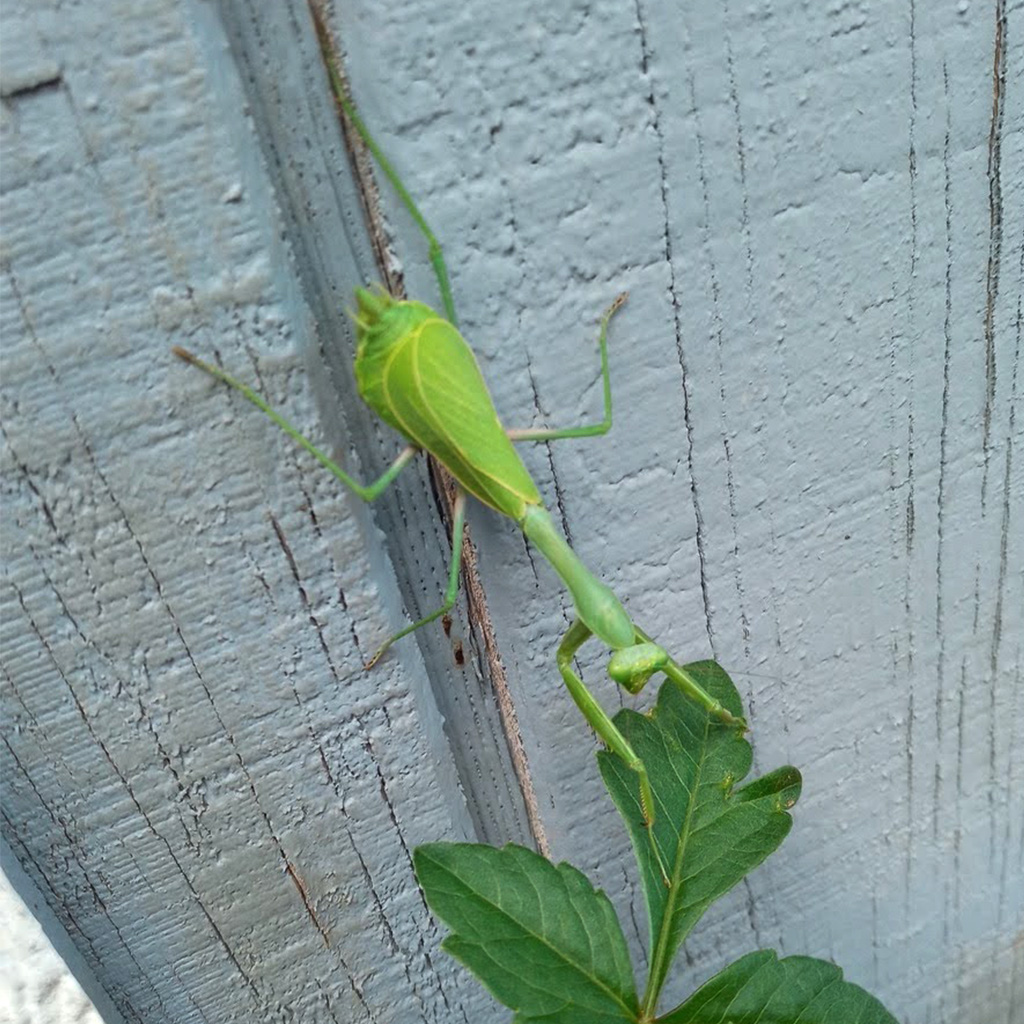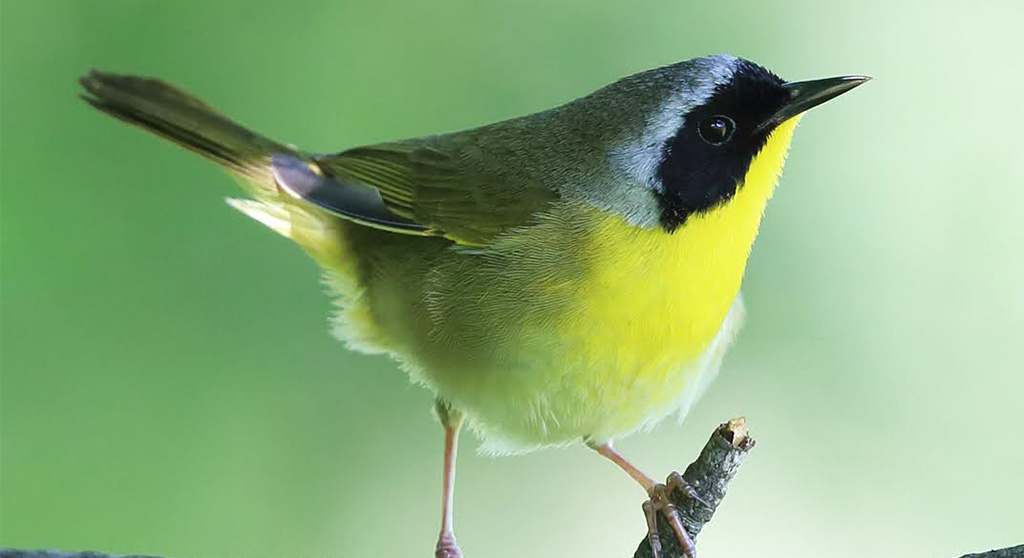Common yellowthroats: Known to wear masks and sneak around nests to avoid being followed

Male yellowthroats sport a distinctive black mask with a white stripe above. (Photo: Tom Murray)
The Swedish botanist and taxonomist Carl Linnaeus first described this yellow warbler in 1766. It was one of the earliest birds he catalogued from North America. At the time, people called this little songbird the Maryland yellowthroat because European settlers first documented the bird in that state. People also sometimes called it the black-masked ground warbler because of the male’s black markings around the eyes. This bird is one of the most familiar warblers in North America. The Springfield minister William Peabody wrote in A Report on the Ornithology of Massachusetts in 1839 that the bird “is one of our most common birds, found among the alders of almost every brook, from the beginning of May till the leaves fall.”
In early May, male yellowthroats arrive at their Northern breeding grounds a week or two before the females. Yellowthroats prefer open areas with low but dense vegetation. Males sing to attract females – a witchety-witchety-witchety song about two seconds long that also stakes out territory – though the females seem to prefer males with larger masks and larger yellow bibs. (The genes associated with these pigments influence male health traits.)

Female yellowthroats are olive above with a buttery yellow throat. (Photo: Tom Murray)
Common yellowthroats, like many songbirds, have a mate with whom they raise young and defend territory. Between May and July, the female lays about four eggs. She sits on the eggs for about two weeks while the male brings her food – but DNA evidence also shows that more than one male typically fathers the eggs in a female’s nest, a cup shape about 3 inches in diameter in a well-hidden place on or near the ground that’s built by the female after mating. The ornithologist William Brewster noted of the bird in 1906: “I have twice found it nesting in ground junipers in perfectly dry upland pastures near Arlington Heights.”
Once the nearly naked chicks hatch, both parents feed them. Because these little birds are commonly preyed upon, the parents work hard not to reveal their nesting spot. When they carry food to a chick, they fly into thick grass nearby. Then they sneak through the grass along the ground to the nest, feed the chicks, and leave in a different direction from which they came. At first, the parents feed the chicks caterpillars or soft-bodied insects. By about the sixth day, the parents bring more challenging food, such as small moths, beetles, mayflies and grasshoppers. After about eight to 10 days, the chicks leave the nest, but they still depend on the parents for quite some time.

A female yellowthroat peeks through autumn leaves in Groton on Oct. 16, 2021. (Photo: Tom Murray)
Despite the care the parents take to hide the nest, brown-headed cowbirds like to lay their eggs in common yellowthroat nests. The cowbirds hope that the yellowthroats will incubate and raise the cowbird young for them. Yellowthroats desert a nest if they recognize cowbird eggs, or if their eggs have been moved or damaged. They start over by building a new nest on top of the old one and its eggs.
The common yellowthroat is one of the most frequent victims of collisions with windows and communication towers or buildings, often at night. These birds hit glass because they see the reflection of vegetation or sky in the window and try to fly into it; they can learn to avoid a specific window, but this knowledge does not protect them from the unfamiliar during migration. They have been killed by flying at night into public buildings, such as Philadelphia’s city hall or the Washington Monument.

A female yellowthroat alights in Huron Village on Aug. 16, 2021. (Photo: Richard George)
Most of these birds migrate south to the Southern United States, the Caribbean, Mexico or Central America. Some leave the North in September, but others wait until October or later. Some of the early migrating birds stop to rest for a few weeks or even a few months. The later migrating birds catch up, and all arrive at their final destination at about the same time. A few birds may not migrate at all, as noted by C.W. Townsend in 1905:
I found a Maryland yellow-throat on December 6th, 1903, in the sand dunes just back of Ipswich Beach . . . . There was about an inch of snow on the ground and the thermometer early in the morning was only 15o F. The bird proved to be a young male, quite fat, with its stomach filled with insects, mostly beetles and flies, and a few small seeds.

A male yellowthroat May 14, 2021, after migrating to North Cambridge in the spring. (Photo: Richard George)
Like the yellowthroat on an Ipswich beach, adult common yellowthroats eat mostly insects, caterpillars and spiders, which they pick off plants or snatch in mid-air. In winter, they may also eat seeds and fruit. These little birds are voracious insect predators. The ornithologist Edward Howe Forbush wrote in 1907 that he saw one “pick off fifty-two gypsy moth larvae before flying away.” He saw another eat 89 aphids in only one minute.
Most common yellowthroats migrate south in late September or October. If you want to see one, look quickly before they are mostly gone for the winter.

A common yellowthroat pauses May 8 in the Cambridge Highlands. (Photo: Kate Estrop)
![]()
Reader photo

Miriam Maske of New Mexico spotted this praying mantis in her flower bed.
![]()
Have you taken photos of our urban wild things? Send your images to Cambridge Day, and we may use them as part of a future feature. Include the photographer’s name, date and the general location where the photo was taken as well as any other relevant information.
Jeanine Farley is an educational writer who has lived in the Boston area for more than 30 years. She enjoys taking photos of our urban wild things.


